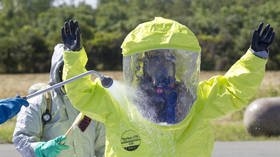Smallpox bioterrorist attack could devastate planet for 10 years

In August 2018, Australian scientists launched a complex international simulation dubbed, ‘Exercise Mataika’, which investigated a ‘worst-case scenario’ for a smallpox bioterrorist attack and the results are horrifying.
Smallpox, one of the most infectious diseases known to man, was officially eradicated in 1980, but two officially known samples of the disease are held in secure laboratories in the US and Russia.
The team’s simulation began with a smallpox bioterrorist attack in Fiji; the first case is reported in a private hospital but is not diagnosed properly as doctors are unfamiliar with the (now effectively-extinct) disease. The hypothetical outbreak then spreads to 200 people, of which roughly 40 percent die.
Potential bioterrorist use of #smallpox should put world on notice, experts say - https://t.co/JcAJAAF5W2 via @Shareaholicpic.twitter.com/BItcBtYwua
— Global Biosecurity (@Globalbiosec) February 20, 2019
As the virus spreads, local health systems are overwhelmed, mass panic ensues, exacerbated by media reports and a 13-day delay in correctly identifying the outbreak. The number of infected quickly rises to 2,000 cases, including doctors, at which point nurses go on strike. The first wave of 32,000 vaccinations arrive in Fiji just as another, larger attack occurs in a more populous country in Asia.
In the study’s worst-case scenario, only 50 percent of people infected with the disease are isolated and only half of the people they had contact with are tracked and vaccinated. This leads to a “catastrophic blow-out in the epidemic.”
“Under these conditions, modelling shows it will take more than a billion doses and 10 years to stop the epidemic,” the researchers explain.
The variola genome, which causes smallpox, is fully sequenced and advances in synthetic biology have increased the likelihood of smallpox being synthesized in a laboratory. In addition, roughly one in five people live with some degree of immunosuppression in developed countries across the globe, while a large proportion of the world population today is unvaccinated.

Biosecurity experts previously scoffed at the potential for a smallpox bioterrorist attack until Canadian scientists reconstructed the extinct horse pox virus in a lab using mail-order DNA in 2017.
Worldwide, the World Health Organization has a stockpile of 34 million vaccine doses from member donations, however, it only has roughly two million in its own possession.
As governments and health organizations work to contain the infection in the simulation, the global workforce is decimated, which severely disrupts transport, power, communications and food infrastructure.
Also on rt.com Anti-vax movement among TOP THREATS to global health, with HIV & Ebola, WHO says“Trust in government and authority structures has disappeared, and legitimate attempts at communication by authorities are viewed with suspicion and fuel conspiracy theories,” the researchers write of the worst-case scenario.
“The results of the exercise are sobering… the results and lessons learned should be considered by every country in the world,” says biosecurity expert Michael Osterholm, the director of the Centre for Infectious Disease Research and Policy (CIDRAP) at Minnesota University.
Like this story? Share it with a friend!












